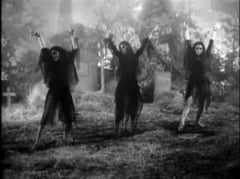The ancestral calendar remains a mystery for most, and yet for over two millennium is coexisted in parallel to Christian holidays, proving not only the continuation of the millenniums old traditions, but also the existence of the same people from the darkness of history to the present day.
In the Romanian popular traditions, the night of 29-30 November, marks the passing from summer to winter, from light to dark, and the rituals conserved from the Geto-Dacian civilization suggests that the night also represented the beginning of a new year. Up to today, the night of 29-30 November, other then being the night of St Andrew in the modern calendar, is the night when the bad spirits cross from one world to another, tormenting the living.
Some of these spirits are the strigoi, a type of national vampire. The strigoi are spirits who after death can not pass into the other world, either because they were wronged in life or because no funeral rites were observed for them. The legends say that strigoi have chalky white skin and a red color around the pupils. Their personality is no longer 'human' like, instead becoming very revengeful, vain and cruel. The strigoi are meant to have an extreme physical power and be able to move incredibly fast.
The legend says that strigoi are very warrior like in appearance and behavior, and when they can't find anyone to fight with, they go around the houses of the living in order to suck the blood of the people unlucky enough to cross their path.
This is the reason for why, in the night of Saint Andrew, the people try to protect themselves from strigoi by rubbing garlic around the doors and windows, the reason for this being that the strigoi dislike the smell of garlic. Also, on this night, the women would turn all cups and pots face down so the strigoi can't hide inside. The ash from the fires is taken out and bread is thrown around the yards so the hungry strigoi can consume the bread.
However, it is extremely rare for strigoi to actually suck the blood of the living. More common is to use spells in order to steal the beauty of the people, or the milk of the cows, the power of the bulls and to bring with them diseases that affect humans, animals and the future crops, or that they terrorize and torment their still living relatives if these relatives wronged them in life. Most legends say that strigoi can transform themselves into wolves, steal and later eat the animals from the villages.
In some villages rites of keeping the strigoi at bay are still practiced. One such tradition is called the Watch of the Garlic. The youngsters of the village get together in a house and after rubbing garlic all around the doors and windows, a merry party is started at sunset. The women would bring with them garlic cloves that would be put in a wooden crate, and an old woman, surrounded by candles, would watch the garlic the entire night, while the youngsters partied with joy, eating, drinking and dancing, not unlike a New Year's Eve. After sunrise, everyone would step out of the houses and the wooden crate containing garlic would be thrown into flames in order to protect the village over the fallowing year.
Another ancient custom observed this night is the custom of sowing wheat grains in a vase. A month later, the newly sprang wheat would be used for divination. The quantity and the height of the wheat would predict the health and the good luck of the sower. Also, maidens would eat very salted bread before going to sleep in the belief that the man that brings them water in the following dreams is the one that they were going to marry.
If the strigoi came around the houses in St Andrew's night, and if someone recognized them, there were ways to make sure that the strigoi were able to fully cross over into the other world. A young white horse would be taken into the graveyard in the morning. If the horse refused to step over a grave, the body was unburied. The legend says that the bodies if the strigoi still look almost alive, only with long hair and nails and are often turned into a different position than at burial. If that was discovered, a wooden stake was impaled into the heart of the strigoi, thus ensuring that the undead becomes truly dead.
